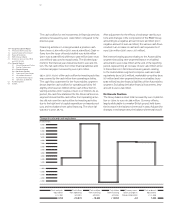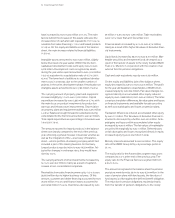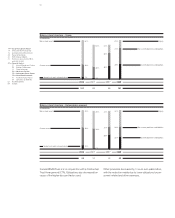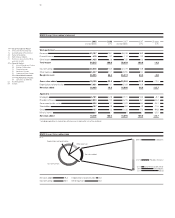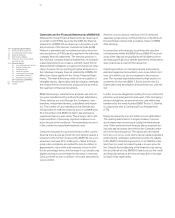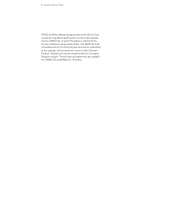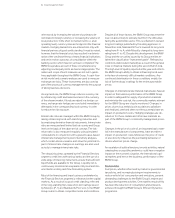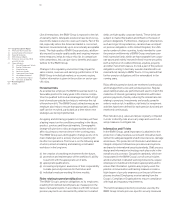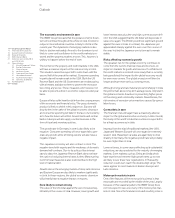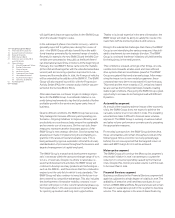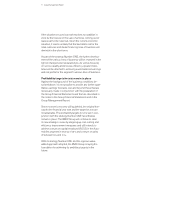BMW 2008 Annual Report Download - page 61
Download and view the complete annual report
Please find page 61 of the 2008 BMW annual report below. You can navigate through the pages in the report by either clicking on the pages listed below, or by using the keyword search tool below to find specific information within the annual report.
62
14 Group Management Report
14 A Review of the Financial Year
16 General Economic Environment
20 Review of Operations
42 BMW Stock and Bonds
45 Disclosures pursuant to § 289 (4)
and § 315 (4) HGB
47 Financial Analysis
47 Internal Management System
49 Earnings Performance
51 Financial Position
52 Net Assets Position
55 Subsequent Events Report
55 Value Added Statement
57 Key Performance Figures
58 Comments on BMW AG
62 Risk Management
68 Outlook
Risk Management
Risk management in the BMW Group
All business activities involve an element of risk. Some
of those risks can be quite substantial. They may arise in
conjunction with business operations or they may affect
a company as a result of changes in external factors. Other
risks arise as business becomes more inter national. As a
globally operating organisation, the BMW Group is
con-
fronted with numerous risks. Price fluctuations on the global
markets for currency, money, capital and commodities as
well as shorter innovation cycles result in ever-increasing
complexity, all of which place great demands on enterprises
with international operations. The downturn that has be-
fallen
the world’s economies over the past year has also
affected the risk profile.
The BMW Group’s approach to business has long been
founded on the idea of consciously taking calculated
risks
and making full use of the opportunities arising from
them. As part of the risk reporting system, the Board of
Management and the Supervisory Board are regularly in-
formed about risks which could have a significant impact
on business performance. This information is derived from
the BMW Group’s integrated risk management system.
Business decisions are reached after consideration of in-
depth project analyses which show both potential risks
and potential opportunities. In addition, as part of long-term
planning, annual budget and short-term forecasts, the
risks and opportunities attached to specific business
activities are evaluated and used as the basis for setting
targets and implementing appropriate risk-mitigation
measures. The groupwide risk management process
comprises the early identification of risks and opportuni-
ties, their measurement and the use of suitable instru-
ments to manage and monitor risks. The risk manage-
ment system comprises a wide range of organisational
and methodological components that are all finely tuned
to each other. The system’s decentralised structure also
encourages a balanced approach to risks at
all organisa-
tional levels.
The Group reporting system provides decision makers with
comprehensive, up-to-date information on performance
against targets and on new developments relating to the
market and competitors. Critical success factors are moni-
tored continuously to ensure that unfavourable develop-
ments are identified at an early stage so that appropriate
counter measures can be implemented and opportunities
exploited.
Standardised rules and procedures, consistently applied
throughout the BMW Group form the basis for an organisa-
tion that is permanently learning. Risk management is a
continuous process since changes in the legal, economic
or regulatory environment or changes within the company
itself could lead to new risks or to known risks being differ-
ently assessed. By regularly sharing experiences with
other companies, the BMW Group ensures that innovative
approaches and ideas flow into the risk management
system and that risk management is subject to continual
improvement. Regular basic and further training as well
as information events are invaluable ways of preparing
people for new or additional requirements with regard to
the processes in which they are involved.
Overall risk management within the BMW Group is man-
aged centrally and reviewed for its appropriateness and
effectiveness by external auditors and by the Group’s inter-
nal audit department. The findings reached serve as the
basis for further improvements.
At present, no risks have been identified which could
threaten the existence of the BMW Group or which could
have a materially adverse impact on the net assets, finan-
cial position or results of operations of the Group. How ever,
risks can never be entirely ruled out.
The areas of risk relevant for the BMW Group are pre-
sented
in the following section. Additional comments on
risks in conjunction with financial instruments are provid-
ed in note of the consolidated financial statements.
Risks relating to the general economic
environment
As a globally operating enterprise, the BMW Group is affect-
ed by global economic conditions. This includes changes
in
exchange rates as well as developments on the financial
markets. The financial crisis and its impact on the world’s
markets for goods and services had a major effect on re-
ported Group revenues and earnings for . In addition
to the effect of changes in demand and refinancing con-
ditions, fluctuations in exchange rates also had a signifi-
cant impact on Group earnings. This related in particular to
the US dollar (the main single source of risk in the BMW
Group’s currency portfolio), the Japanese yen, the British
pound and the Chinese renminbi. Based on forecasts,
these four currencies account for some of the foreign
currency exposure of the BMW Group.
The BMW Group manages currency risks both at a strate-
gic and at an operating level. At a strategic level (i. e. in
the medium and long term), the BMW Group endeavours
to manage foreign exchange risks by “natural hedging”, in


